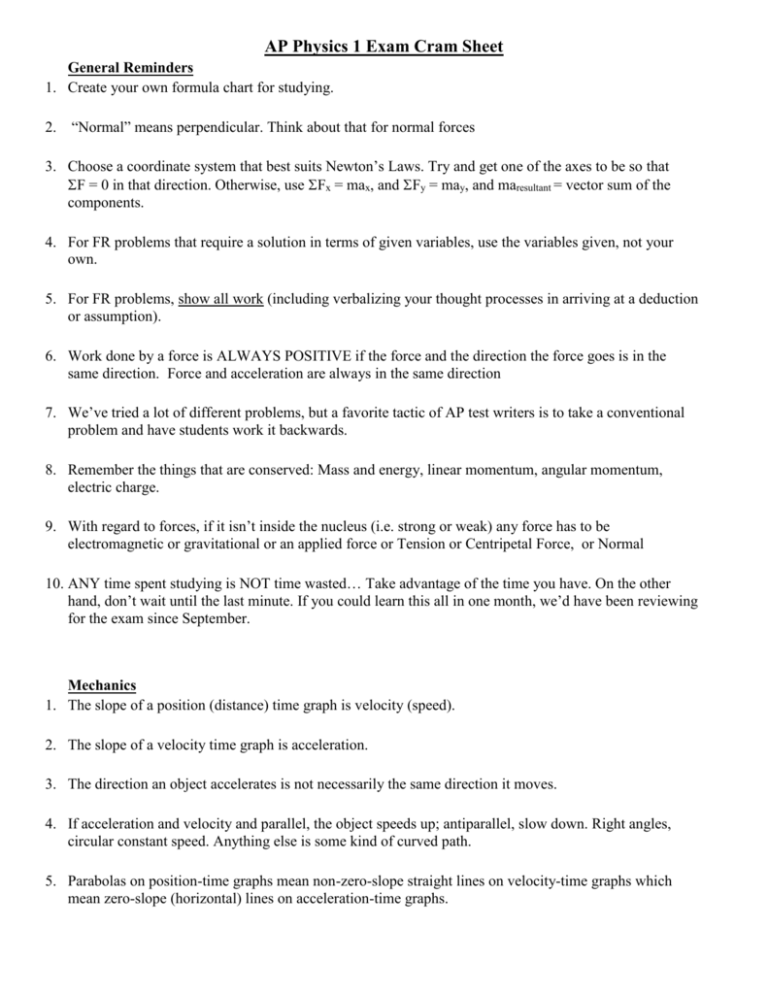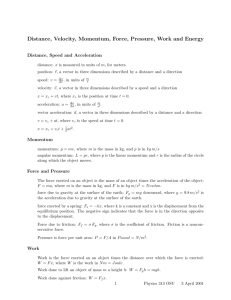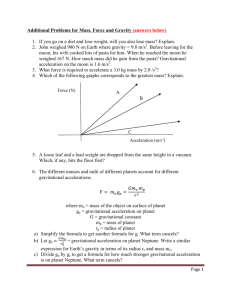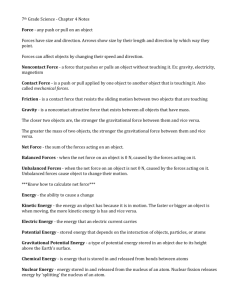AP Physics 1 Exam Cram Sheet: Mechanics & E/M Review
advertisement

AP Physics 1 Exam Cram Sheet General Reminders 1. Create your own formula chart for studying. 2. “Normal” means perpendicular. Think about that for normal forces 3. Choose a coordinate system that best suits Newton’s Laws. Try and get one of the axes to be so that F = 0 in that direction. Otherwise, use Fx = max, and Fy = may, and maresultant = vector sum of the components. 4. For FR problems that require a solution in terms of given variables, use the variables given, not your own. 5. For FR problems, show all work (including verbalizing your thought processes in arriving at a deduction or assumption). 6. Work done by a force is ALWAYS POSITIVE if the force and the direction the force goes is in the same direction. Force and acceleration are always in the same direction 7. We’ve tried a lot of different problems, but a favorite tactic of AP test writers is to take a conventional problem and have students work it backwards. 8. Remember the things that are conserved: Mass and energy, linear momentum, angular momentum, electric charge. 9. With regard to forces, if it isn’t inside the nucleus (i.e. strong or weak) any force has to be electromagnetic or gravitational or an applied force or Tension or Centripetal Force, or Normal 10. ANY time spent studying is NOT time wasted… Take advantage of the time you have. On the other hand, don’t wait until the last minute. If you could learn this all in one month, we’d have been reviewing for the exam since September. Mechanics 1. The slope of a position (distance) time graph is velocity (speed). 2. The slope of a velocity time graph is acceleration. 3. The direction an object accelerates is not necessarily the same direction it moves. 4. If acceleration and velocity and parallel, the object speeds up; antiparallel, slow down. Right angles, circular constant speed. Anything else is some kind of curved path. 5. Parabolas on position-time graphs mean non-zero-slope straight lines on velocity-time graphs which mean zero-slope (horizontal) lines on acceleration-time graphs. 6. Area under a velocity time graph is displacement (change in position). Areas below the time axis represent negative displacements. 7. As a falling object approaches terminal velocity, speed increases and acceleration decreases. 8. Newton’s 1st or 2nd Law always applies. Newton’s 3rd Law always applies. 9. If the object is at rest or moving at a constant velocity, N1 applies. Otherwise N2 applies. 10. If an object is moving in a curve, there must be a net force towards the inside of the curve. 11. If an object is moving in a circle, there must be a component of the net force towards the center equal to F^ = m v2 r . 12. The centripetal force is always a force easily identified (or the component of one…), e.g. friction, tension, gravity, normal, or combinations. 13. The only force on any projectile (neglecting air friction) is the projectile’s weight (directed downwards). 14. A ball rolled off a horizontal table will take the same amount of time to hit the ground as another dropped from the same height. 15. The tension in a rope holding an object in equilibrium is equal to the weight of the object. If the object is accelerating upwards, T > mg. If the object is accelerating downwards, T < mg. 16. The angle of an inclined plane is the same as the angle between the line of weight of the object on the incline and the normal line. 17. Static friction is a range of values such that 0 f s N . Kinetic (sliding) friction is just f k N . 18. The mass of a satellite doesn’t matter. The only thing that matters is the mass of the thing being orbited and the orbital radius. 19. Geosynchronous orbit is approximately 22,300 mi. above the earth’s surface on the equatorial plane. 20. The closer a satellite is to what it orbits, the faster its orbital speed. 21. For satellites, the centripetal force is gravity: F GMm r2 mv 2 r (assuming the orbit is circular and M >>> m). 22. For satellites and planets, angular momentum (L = mvr) is always conserved (in the absence of any outside forces/torques). In other words, the closer a planet is to the sun, the faster it goes. 23. The paths of planets and satellites are approximately circular, but are actually elliptical. 24. The gravitational force (and the resulting acceleration) due to a planet varies directly with the distance from the center of the planet when the object is INSIDE the planet. 25. The gravitational force (and the resulting acceleration) due to a planet varies inversely with the square of the distance from the center of the planet when the object is outside the planet. 26. A planet’s gravitational field is greatest at its surface (assuming it’s spherical). 27. A planet’s measured gravitational field is less at the equator than at the poles due to the planet’s rotation. 28. The tension in a string holding up an object is not always equal to the object’s weight. 29. The normal force exerted on an object (even on a horizontal surface) is not always equal to the object’s weight. 30. The direction an object will go is the same as the direction of the unbalanced force that makes it go, only if the initial speed is zero. 31. For (modified) Atwood’s machines, consider a general direction for the acceleration, even if it’s not obvious. 32. Conical pendulums: Ty = mg, Tx = mv2/r. 33. In N3, the reaction force is always the same kind of force as the first one (the reaction to a frictional force is another frictional force, the reaction to a gravitational force is another gravitational force). 34. The Law of Conservation of Momentum is based on the action-reaction pair of forces in Newton’s 3rd Law. 35. If conservative forces are the only forces doing work, mechanical energy is conserved. 36. Work done by conservative forces is path independent. 37. Power is the time rate of change of work or energy, but it can also be calculated using force speed. 38. spring : pendulum :: spring constant : gravity :: mass attached : length. 39. If a mass on a spring hangs at rest a distance d, it will fall a distance 2d (measured from where the spring has no potential energy). 40. In a collision between massive particles, momentum is ALWAYS conserved. 41. “Inelastic collisions” mean kinetic energy is not conserved, energy is lost to friction. 42. “Completely inelastic” only means the objects stick together, not that all energy is lost (although some must be lost or gained – hence the term “inelastic”). 43. “Perfectly elastic” means kinetic energy is conserved. 44. The first step in any torque problem is to determine the point about which torques are calculated. 45. The work done by any centripetal force is always zero. 46. The mass of a pendulum doesn’t matter. 47. If an object strikes a surface, the normal force exerted on the object must include the force required to change the object’s momentum. 48. Normal forces generally don’t do work. 49. If two objects with mass collide, you MUST use momentum conservation at some point. 50. Consider variations on the ballistic pendulum (e.g. 1995:1). 51. The area under a force-position (displacement) graph is work (energy). 52. The work done in stopping an object is equal to its initial kinetic energy (likewise, the work done in getting an object up to speed is equal to its final kinetic energy). 53. In any before-after situation, if there is a change in kinetic energy, work must have been done. 54. Conservative fields are defined by potential energy functions (gravitational, elastic, electric). Watch out for the hypothetical conservative field. 55. Potential energy is generally considered an assigned (arbitrary) energy due to position. 56. If you’re being asked for the kinetic energy of an object, don’t be too quick to use K = 12 mv 2 unless the mass and speed are obvious and available. Think about using work-energy considerations. 57. Also, don’t forget the relation between kinetic energy and momentum: K = 58. Torque is a vector cross product. 59. Work is a dot scalar product. p2 2m . . . 60. An object can be in translational or rotational equilibrium or both or neither. 61. Work done by kinetic friction is negative. 62. This equation goes a long way: ; the first part is applicable to waves. Charged Surfaces and Spheres (Electrostatics) 1. Excess charge resides on the outer surface of a conductor. 2. The field anywhere inside a conductor in electrostatic equilibrium is zero. 3. The electric potential on the surface of conducting sphere is inversely proportional to radius of the sphere. (i.e. given the same quantity of charge, surfaces of smaller spheres are at a higher quantity of potential). 4. On irregularly shaped conductors, the surface charge density (and therefore the field and potential) is higher at locations where the radius of curvature is smallest (like ends of lightning rods and golf clubs). 5. If two charged objects are connected by a conductor, the difference in potential will cause the charges to move until the potentials are the same. And don’t forget, positive charges move from high to low potential – negative charges (e.g. electrons) go from low to high potential. 6. For a conducting sphere of radius R , The electric field at the surface is E kQ R2 . The field anywhere inside the sphere is 0. The field at a distance r away from the center of the sphere (where r R ) is E kQ r2 . 7. For the same conducting sphere, The potential at the surface is V kQ R . The potential anywhere inside the sphere is the same as at the surface, otherwise there would be a difference in potential and therefore an electric field that is ¹ 0. The potential at a distance r away from the center of the sphere (where r > R ) is V = kQ r . 8. For an insulating sphere of uniform charge density, the field inside the sphere varies directly with the distance from the center (just like gravitational fields inside the earth). Outside it’s like the case above. Electricity & Magnetism 1. Almost everything in electrostatics can be derived from Coulomb’s Law F = kQq r2 2. Remember to distinguish between what causes a field and what a field does to a charged particle. 3. For our purposes, an object cannot be affected by its own field. 4. Fields exert forces. It’s what they do. It’s what they are. It’s their job. 5. Forces and potential energies are associated with particles. Fields and potentials are associated with points in space. 6. Positive charges want to go from regions of high potential to regions of low potential. 7. The direction of electric field is the direction of the force the field exerts on a positive charge. Or, the direction of electric field is the same as the direction from high potential to low potential. 8. Fields and forces are vectors. They have directions according to their signs. Strip the signs and do vector math. 9. Potential and potential energy are scalars. Keep the signs (!) and just add. 10. For potential and potential energy, the reference point (where V = 0 and U = 0) is r = ¥ . 11. For the motion of a charged particle in an electric field, use the system of equations for constant acceleration that we used for projectiles. 12. Don’t use V = Ed for point charges and don’t use V = kq r or E = kq r2 for parallel plates. 13. If you have to do vector math to find the field due to several charges at a given point, the total force on a charge placed on that point is simply SF = q(SE ) . Don’t do vector math twice for the same concept. 14. No work is done in moving a charged object along a line or surface of equipotential. (W=qV=0) 15. One electron volt is the amount of energy an electron (or a proton) acquires when it is accelerated from rest through a difference in potential of one volt. (W=qV=K). series total charge/curren t voltage Resistors add ‘em up parallel Resistors inverse thing same I = R/V (adds up) V=IR (adds up) same 16. The direction of conventional current is the way positive charges go in a circuit. 17. Resistivity is a general characteristic of a material (e.g. copper) while resistance is a specific characteristic of a sample of a material (e.g. 2 ft of 14 gauge copper wire). 18. Resistance is proportional to length and inversely proportional to cross-sectional area. 19. Superconductors have zero resistance when cooled below a critical temperature (different for different materials). Currently, high temperature superconductors – ceramics mostly - have critical temperatures of around 100 K). 20. Stuff that requires a lot of heat uses the most electricity. 21. The equivalent resistance of any two identical resistors in parallel is half of either resistor. (e.g. 2 8- resistors in parallel give an eq. R = 4-). 22. The equivalent resistance of any number of resistors in parallel is always less than that of the smallest resistor. 23. Kirchhoff’s Loop Rule (V = 0) is an expression of conservation of energy (per unit charge). 24. Kirchhoff’s Point Rule (I = 0) is an expression of conservation of electric charge (per unit time). 25. Voltmeters have a high resistance (to keep from drawing current) and are wired in parallel (because voltage is the same in parallel). 26. Ammeters have a low resistance (to keep from reducing the current) and are wired in series (because current is the same in series). 27. A light bulb lights up because of current. The more current, the brighter it is. Generally, we’ll treat the resistance of the light bulb as ohmic (i.e. constant – it follows Ohm’s Law), although actually most metallic conductors increase in resistance when heated. Waves 1. Mechanical waves can be longitudinal (displacement is parallel to motion) or transverse (displacement is perpendicular to motion). EM waves are treated as transverse waves. 2. Sound is a longitudinal wave. 3. On a string (or in a pipe) where a standing wave occurs, the number of loops (antinodes) is the number of the harmonic. 4. The open end of a pipe is always a pressure node because it stays at atmospheric pressure. 5. Frequency : pitch :: amplitude : loudness :: harmonic content : timbre (tone quality). 6. The speed of a wave depends only on the properties of the medium. This is true for mechanical as well as EM waves. 7. Wave energy is generally directly associated with amplitude (do not confuse this with quantum ideas…). 8. Properties of waves include refraction, superposition & interference, and diffraction. Waves also reflect, but so do particles. 9. Waves in phase are said to be coherent.






